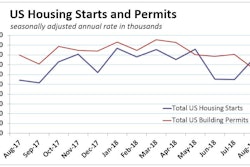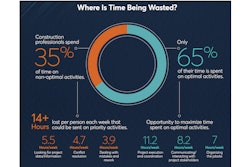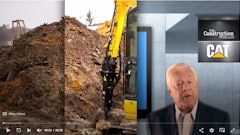Construction News Tracker is presented by Caterpillar and produced by ForConstructionPros.com.
Cleanup crews are working their way through the devastation left behind along the eastern seaboard by Hurricane Florence. The rebuilding effort is likely to take months if not years after the devastating storm left miles of destruction as it pummeled its way across the region. Many roadways have been washed out by floodwaters and will have to be rebuilt. The Federal DOT has released $40 million in emergency funds for infrastructure repairs by North Carolina DOT. Recovery efforts in many locations are having to wait out flood waters to recede before accessing them.
The U.S. Department of Commerce reports the nation’s housing industry is back on schedule. Housing starts increased 9.2% in August to a seasonally adjusted high of 1.28 million units following declines in July of 3/10ths of a percent and 11.4% in June — the biggest advance since January. Applications for building permits, however, are off by 5.7% in August after rising in July. The struggle for builders continues as prices for lumber, land and labor continue to climb. Lumber prices alone have shot up by $7,000 per unit since 2017. Most of the August surge is being attributed to multi family housing, which rose in August by 29.3%.
Prices for construction goods and services continue to rise. AGC is reporting that the increase averaged 6.2% over the past year, and they come as many firms continue to cope with labor shortages and higher tariffs on certain products. The prices are climbing at nearly double the rate that contractors have raised their bid prices to construct new buildings over the past year. One example is diesel fuel. The Producer Price Index for inputs shows the price declined between July and August by 8/10ths of a percent, but for the year rose 33%. Steel, aluminum and asphalt were just some of the key categories that indicate contractors are paying more for but have failed to bid properly to cover their costs.
It’s a $177 billion annual cost to the industry. That’s what a new report from PlanGrid and FMI Corp claims construction spends on rework, conflict resolution and looking for project data. The team surveyed 600 professionals - 336 of them in construction - under the banner Construction Disconnected. Of the total responding, 49% were general contractors, 36% were in specialty trades and 15% were developers. The net result is that 35% of their time is spent on non-optimal work which translates to 14 hours per person per week in lost productivity. Much of this is seen as poor communication and poor project information which could be improved substantially with a keener sense of accomplishment.
A pilot project to help contractors build and maintain longer lasting roads has just been implemented. The National Center for Asphalt Technology and Minnesota DOT are engaged along with Cargill Corporation with testing in northern and southern climates. NCAT wants to determine how to best implement mix design procedures, particularly those containing rejuvenators and rap. Cargill, a big supplier to the industry, is interested in looking beyond recipe specs to focus on real world results. NCAT’s site at Opelika, AL, and the MinnDOT site at Albertville, MN, should give all the parties the answers they seek in the multi year effort.
An ambitious plan to build some 60 miles of concrete seawalls, earthen barriers, floating gates and steel levees along the Texas Gulf Coast is being touted as a means to control future flooding such as seen by Hurricane Harvey. Dubbed the Coastal Spine, the project — to exceed $12 billion — would run from the Louisiana border to the Texas Gulf Coast south of Houston and home to most of the state’s 30 petrochemical refineries. Public funding would be used to pay for the “spine” and the federal government has already kicked in $3.9 billion for three smaller storm barrier projects which would be part of the larger overall massive endeavor. Opponents claim the oil and gas industry would get a free ride if the entire project was approved using all public money.
In closing, remember, great accomplishments have resulted from the transmission of ideas and enthusiasm.
This is Construction News Tracker looking over the industry that makes the world a better place, presented by Caterpillar and produced by ForConstructionPros.com.
Follow us on social media at Twitter using #constructionnews,YouTube and Facebook as the streaming Web never ends.



















